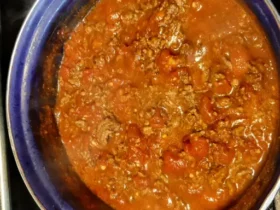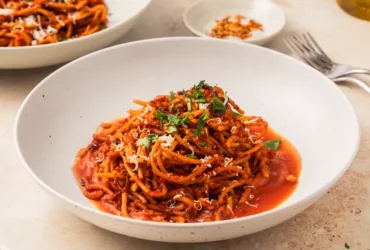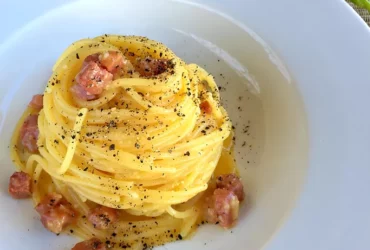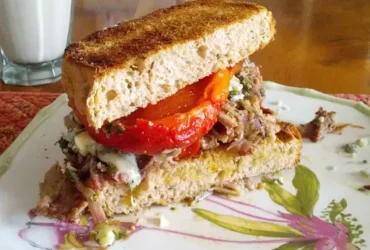Ingredients
Pantry Staples
Pantry Staples for the Perfect Fresh Peach Galette
A good pastry dough and a few essential pantry staples are all you need to make a delicious fresh peach galette.
Essential Pantry Staples
- All-purpose flour: The foundation of any great pastry dough, use high-quality unbleached all-purpose flour for the best results.
- Salt: Add a pinch of salt to enhance flavors and balance sweetness in your galette.
- Granulated sugar: A small amount adds natural sweetness without overpowering other flavors.
- Baking powder: A gentle leavening agent that helps the pastry rise without making it too dense.
- Use high-quality, salt-free butter for an optimal flavor profile.
Additional Ingredients
- Fresh peaches: The star of the show! Choose ripe but firm peaches for the best results.
- Almond extract: A hint of almond flavor complements peach sweetness beautifully.
- Water: Use as needed to achieve the perfect consistency in your pastry dough.
Tips and Variations
To take your fresh peach galette to the next level, try these tips:
- Add a hint of spice: A pinch of cinnamon or nutmeg can add depth to your galette.
- Use different types of sugar: Experiment with brown sugar, turbinado sugar, or Demerara sugar for unique flavor profiles.
- Add some texture: Mix in chopped nuts (almonds, walnuts, or pecans work well) or chocolate chips for added texture and interest.
By incorporating these pantry staples and additional ingredients into your fresh peach galette recipe, you’ll be creating a dessert that’s both delicious and visually stunning!
1 cup all purpose flour
All-purpose flour, a staple ingredient in baking, serves as a fundamental component in the preparation of the Fresh Peach Galette. The most commonly used measure for this purpose is one cup.
The importance of using all-purpose flour lies in its unique blend of strength and delicacy. It possesses an ideal balance of protein content, which enables it to effectively hold together ingredients while also providing a tender crumb to finished baked goods.
When measuring one cup of all-purpose flour for the Fresh Peach Galette recipe, it is crucial to consider the method used. Dry ingredients such as flour can sometimes pack down during measurement, resulting in an inaccurate quantity.
To accurately measure one cup of all-purpose flour, it is recommended to use the scoop-and-level technique. This involves scooping the flour into a measuring cup and then leveling off the top with a straight edge or knife to ensure that no excess flour is added.
For those using digital kitchen scales for measurement, one cup of all-purpose flour typically weighs around 120-125 grams depending on the specific brand and type used. However, it’s essential to note that this weight measure should be considered alongside the scoop-and-level method, not as a replacement for it.
Some potential variations in all-purpose flour include bread flour and cake flour. Bread flour contains a higher protein content than all-purpose flour, making it more suited for yeast-based doughs and those requiring greater strength. In contrast, cake flour has a lower protein content, resulting in a delicate texture that’s ideal for cakes and pastries.
For the Fresh Peach Galette recipe specifically, all-purpose flour serves as an essential component in creating a flaky yet sturdy crust. The combination of the right amount and type of flour is crucial to achieving the desired texture and structure in this dessert.
1/4 cup granulated sugar
When it comes to making a delicious Fresh Peach Galette, one of the essential ingredients that contribute to its sweetness and flavor is granulated sugar.
Granulated sugar, also known as white or table sugar, is a refined sugar made from sugarcane or sugar beets. It is a popular ingredient in baking due to its versatility and ability to add sweetness without adding flavor.
In the context of this Fresh Peach Galette recipe, 1/4 cup of granulated sugar serves several purposes:
Firstly, it helps balance the tartness of the peaches, which are a key ingredient in this dessert. By adding a touch of sweetness to the mixture, the sugar enhances the overall flavor profile and creates a delightful harmony between sweet and tangy.
Secondly, granulated sugar helps to caramelize the peach juices and create a golden-brown crust on the galette during baking. This caramelization process not only adds visual appeal but also enhances the texture of the dish, making it more complex and engaging.
The 1/4 cup of granulated sugar used in this recipe is an ideal amount for achieving a perfect balance of flavors without overpowering the natural sweetness of the peaches. It’s also worth noting that the type of sugar used can affect the final texture and flavor of the galette, so it’s best to use high-quality granulated sugar for optimal results.
In summary, 1/4 cup of granulated sugar is a crucial ingredient in this Fresh Peach Galette recipe, adding sweetness, balancing flavors, and enhancing the overall texture and appearance of the dish. Its versatility and ability to add depth without overpowering make it an excellent choice for this dessert.
1 teaspoon salt
When it comes to adding flavor and texture to our Fresh Peach Galette Recipe, we need to consider the right balance of ingredients.
One essential component in this recipe is salt. And, specifically, we’re looking at using about 1 teaspoon of salt.
The role of salt in baking is multifaceted. Not only does it enhance the flavor of other ingredients, but it also helps control yeast growth, strengthens gluten structures, and balances sweetness levels.
However, when working with sweet ingredients like fresh peaches, it’s crucial to use the right type of salt. You can choose from several options, including flaky sea salt, kosher salt, or even table salt. For this recipe, a mild-tasting salt like kosher salt is an excellent choice.
The 1 teaspoon of salt recommended in the recipe might seem like a small amount, but it’s crucial for balancing the sweetness of the peaches and other ingredients. If you’re unsure about how much salt to use, start with this amount and adjust to taste in future batches.
Incorporating 1 teaspoon of salt into your Fresh Peach Galette Recipe is an easy way to elevate the flavors and textures of this dessert. By balancing the sweetness levels and adding a touch of savory flavor, you’ll be on your way to creating a truly exceptional dessert that’s sure to impress your friends and family.
1/2 cup cold unsalted butter, cut into small pieces
When it comes to making a delicious Fresh Peach Galette, one of the most crucial ingredients is cold unsalted butter. The use of this type of butter is essential as it provides flavor and tenderness to the pastry crust.
Cold unsalted butter, specifically 1/2 cup in quantity, should be carefully cut into small pieces. This ensures that when mixed with other dry ingredients like flour, sugar, and salt, the butter breaks down evenly and creates a flaky texture throughout the dough.
It’s also worth noting that cold butter is easier to work with than softened or melted butter. When butter is too warm, it can cause the sugar to melt and create a sticky dough that’s challenging to shape into a galette form.
The importance of using high-quality butter cannot be overstated. Unsalted butter has a neutral flavor that won’t compete with the sweetness of the peaches, allowing the natural flavors of both ingredients to shine through in the finished galette.
Fresh Peaches
- Fresh peaches are the star ingredient in a classic Fresh Peach Galette Recipe, providing natural sweetness and juiciness to the dessert.
- To choose the best fresh peaches for your galette, look for those with a sweet aroma and slightly soft flesh, but still firm enough to hold their shape when sliced.
- The seasonality of fresh peaches can vary depending on your location, but in general, they are available from May to October, making them an ideal summer dessert ingredient.
- A ripe fresh peach should have a sweet, fruity aroma and a slightly soft flesh that yields to pressure. If it’s too hard or too soft, it may not be at its best flavor and texture.
- For the best flavor and texture in your galette, use a combination of sweet and tart fresh peaches, such as Bartlett, Red Haven, and Crimson Lady.
- You can find fresh peaches at most grocery stores or farmers’ markets during peak season. When selecting them, choose those that are firm but still give slightly to the touch, with no soft spots or bruises.
3 large ripe peaches, sliced into wedges
The star ingredient for this Fresh Peach Galette Recipe are three large, ripe peaches. When selecting peaches, look for ones that have a sweet aroma and are slightly soft to the touch. This will ensure that they are juicy and flavorful.
The next step is to slice the peaches into wedges. You can slice them in any direction you prefer, but try to make uniform slices so that they cook evenly in the galette.
For this recipe, we recommend using 3 large peaches because they provide a good balance of sweetness and texture to the filling. However, feel free to use more or fewer peaches depending on your personal preference and the size of your galette.
The type of peach you choose is also important. A combination of sweet and tart flavors will work well in this recipe. Some popular varieties for baking include Red Haven, Belle of Georgia, and Zee Lady.
When slicing the peaches, try to remove any seeds or pits to prevent them from getting in the way of the filling. This will also make it easier to arrange the peach slices in a pattern on the galette dough.
Now that we have our sliced peaches ready, let’s move on to the next step: assembling the galette crust and arranging the filling. With these beautiful peaches at the center of our dish, we can focus on bringing them all together for a show-stopping dessert!
Instructions
Peach Filling Preparation
To prepare the peach filling for our fresh peach galette recipe, follow these steps:
Preparation of Peaches:
- Wash and dry 3-4 ripe peaches.
- Peel, pit, and slice the peaches into wedges.
Preparation of Sugar Mixture:
In a separate bowl, mix together:
- 1/2 cup granulated sugar
- 2 tablespoons cornstarch
- 1 tablespoon lemon juice
- 1/4 teaspoon ground cinnamon (optional)
- Tossing Peaches with Sugar Mixture:
- Add the sliced peaches to the bowl with the sugar mixture.
- Toss gently to coat the peaches evenly, making sure they are well-covered by the sugar mixture.
- Let the peach slices sit for about 15-20 minutes, allowing them to release their juices and become syrupy.
Preparing Galette Topping:
Meanwhile, prepare the topping ingredients:
- 1 cup all-purpose flour
- 1/4 cup granulated sugar
- 1/2 teaspoon salt
- 1/2 cup cold unsalted butter, cut into small pieces
- Mix the flour, sugar, and salt together in a separate bowl.
- Add the cold butter to the bowl and use your fingers or a pastry blender to work it into the dry ingredients until the mixture resembles coarse crumbs.
In a separate bowl, whisk together sugar and cornstarch to prevent peach juices from making the mixture too runny.
In the realm of instructions, it’s essential to provide clear and concise guidance that enables individuals to execute a task effectively. In the context of cooking, especially in baking, instructions play a crucial role in ensuring that the final product meets expectations.
The given instruction – “In a separate bowl, whisk together sugar and cornstarch to prevent peach juices from making the mixture too runny” – exemplifies this principle. This instruction is part of a larger recipe, specifically for Fresh Peach Galette, which involves combining various ingredients to create a unique dessert.
The use of specific language in this instruction contributes significantly to its clarity. By specifying “a separate bowl,” the reader knows exactly where to mix the sugar and cornstarch. The action “whisk together” provides further guidance on how to combine these dry ingredients, ensuring they are evenly mixed without introducing any lumps or air pockets.
The phrase “to prevent peach juices from making the mixture too runny” serves as an additional layer of clarity, explaining the purpose behind this step in the recipe. This is particularly important in baking, where small changes can significantly affect the final texture and consistency of a product.
Effective instructions often utilize active voice to make them more engaging and easier to follow. In the provided instruction, the use of the active verb “whisk” contributes to this effect, making it clear that the reader is responsible for carrying out this action.
The importance of timing in cooking is also highlighted by this instruction. Whisking together sugar and cornstarch at the right moment prevents the mixture from becoming too runny due to peach juices. This demonstrates the significance of executing instructions at the correct time to achieve desired results.
In addition, this instruction showcases the value of experimentation and creativity in cooking. By adjusting the proportions of sugar and cornstarch or by introducing additional ingredients, readers can adapt this recipe to suit their personal tastes and preferences.
When considering the broader context of cooking instructions, it’s clear that clarity, specificity, and attention to detail are essential components. In the case of this instruction, each element contributes to the creation of a comprehensive and easy-to-follow guide for preparing Fresh Peach Galette.
Listed Benefits of Clear Instructions in Cooking
- Clarity: Clearly stated instructions enable readers to execute tasks without confusion or misunderstandings.
- Specificity: Providing precise details on actions, ingredients, and quantities helps ensure accurate execution.
- Creativity: By offering a foundation for experimentation and adaptation, clear instructions empower cooks to develop unique recipes.
- Time Management: Effective timing is crucial in cooking, and clear instructions help readers execute tasks at the right moment.
- Confidence Building: Clear instructions promote confidence among novice cooks by providing them with a clear understanding of what to do and when.
Galette Assembly
To assemble the Galette, start by placing a large sheet of parchment paper on a flat surface.
Sprinkle a light dusting of granulated sugar over the center of the parchment, leaving a 1-inch border around the edges. This will help prevent the pastry from sticking to the paper as it bakes.
Roll out the puff pastry to a thickness of about 1/8 inch (3 mm). You can use store-bought puff pastry or make your own, but keep in mind that homemade puff pastry can be more finicky and requires some practice to get right.
Lay the rolled-out puff pastry over the parchment paper, making sure it covers the entire surface. Trim any excess pastry from the edges, leaving a 1-inch border around the filling area.
Spread the fresh peach mixture evenly over the center of the pastry, leaving a 1-inch border around the edges. This will help prevent the filling from spilling out during baking.
Gently fold the edges of the pastry up over the filling, pressing the pastry gently to seal. Use your fingers or a fork to crimp the pastry and create a decorative border.
Brush the top of the galette with a little bit of melted butter, then sprinkle with some extra sugar. This will give the galette a nice glaze and help it brown evenly during baking.
Carefully transfer the assembled galette to a baking sheet lined with parchment paper, making sure not to damage the pastry or spill any of the filling. Bake at 375°F (190°C) for about 40-50 minutes, or until the pastry is golden brown and the filling is bubbly and tender.
Remove the Galette from the oven and let it cool on a wire rack for at least 10-15 minutes before slicing. Serve warm or at room temperature, garnished with fresh whipped cream or vanilla ice cream if desired.
Roll out pastry dough on a lightly floured surface, to about 1/4inch thickness.
To begin making the Fresh Peach Galette, it’s essential to work with a lightly floured surface when handling the pastry dough.
The first step involves rolling out the pastry dough on this prepared surface to an even thickness. For a galette, you’re aiming for about 1/4 inch or roughly 6-7 millimeters in thickness.
This requires some patience and gentle manipulation of the dough to avoid developing the gluten too much and making it tough. It’s crucial to keep the rolling motion even and consistent to achieve a uniform thickness throughout the dough.
As you roll, make sure the surface is lightly floured to prevent the dough from sticking and to facilitate smooth rolling. You can also dust the top of the dough with a small amount of flour if necessary, but be cautious not to overdo it, as this could lead to an uneven thickness.
It’s worth noting that the goal is not to roll out a perfect circle or rectangle, but rather to achieve a smooth, even surface. Any imperfections or irregularities will likely be hidden by the toppings and won’t affect the overall appearance of the finished galette.
Once you’ve reached the desired thickness, gently place the rolled-out dough onto a parchment-lined baking sheet or a lightly floured pizza peel. This will make it easier to transfer the dough to the oven later on.
Baking Instructions
To successfully make a delicious Fresh Peach Galette, it’s essential to follow the provided baking instructions carefully and in order.
Step 1: Preparing the Pastry Dough
Mix together 2 cups of all-purpose flour, 1 teaspoon of salt, and 1/4 cup of granulated sugar in a large bowl until well combined.
Add 1/2 cup of cold unsalted butter to the dry ingredients and use a pastry blender or your fingertips to work it into the mixture until the dough resembles coarse crumbs.
In a separate bowl, whisk together 1 egg and 1 tablespoon of water until well beaten. Add this mixture to the flour mixture and stir with a fork until the dough starts to come together in a ball.
Step 2: Chilling the Pastry Dough
Turn the pastry dough out onto a lightly floured surface and gently knead it a few times until it becomes smooth and pliable.
Shape the dough into a flat disc and wrap it tightly in plastic wrap. Refrigerate for at least 30 minutes or up to 2 hours to allow the gluten to relax.
Step 3: Preparing the Fresh Peaches
Peel, core, and slice 4-5 fresh peaches into wedges, depending on their size.
In a small bowl, mix together 1 tablespoon of granulated sugar and 1 tablespoon of cornstarch. Add this mixture to the peach wedges and toss until they are evenly coated.
Step 4: Assembling the Galette
On a lightly floured surface, roll out the chilled pastry dough to a thickness of about 1/8 inch (3 mm).
Mix together 1 tablespoon of granulated sugar and 1 tablespoon of cornstarch in a small bowl. Sprinkle this mixture evenly over the center of the dough, leaving a 2-inch (5 cm) border around the edges.
Step 5: Adding the Fresh Peaches
Arrange the peach wedges on top of the sugar and cornstarch mixture, slightly overlapping each other to create a pattern. Leave a small space between each peach wedge for even cooking.
Sprinkle any remaining granulated sugar and cornstarch mixture over the peaches.
Step 6: Folding the Pastry Dough
Brush the edges of the pastry dough with a little bit of water, then fold the edges over the filling to create a crust. Make sure to tuck in any stray pastry pieces as you go.
Use your fingers or a fork to crimp the edges of the crust, pressing gently to seal the galette.
Step 7: Baking the Galette
Preheat your oven to 375°F (190°C) and place a baking sheet lined with parchment paper on the middle rack. Place the galette in the center of the baking sheet, leaving space between it and any other baked goods or utensils.
Bake for 35-40 minutes, or until the pastry crust is golden brown and the peaches are tender. If the edges start to brown too quickly, cover them with foil to prevent overcooking.
Step 8: Serving the Galette
Remove the galette from the oven and let it cool for at least 10-15 minutes before serving. Slice into wedges or individual pieces and serve warm, dusting with powdered sugar if desired. Enjoy your delicious Fresh Peach Galette!
Preheat oven to 375°F (190°C).
The first step in making this delectable Fresh Peach Galette is to preheat the oven to a precise temperature, which is essential for achieving the perfect texture and flavor of the crust. Preheating the oven to 375°F (190°C) allows it to reach its optimal temperature, ensuring that the crust will bake evenly and not too quickly or slowly. This initial step sets the foundation for the rest of the recipe, as a perfectly baked crust is crucial in holding together the delicate filling of fresh peaches.
It’s worth noting that using a digital oven thermometer can help ensure accuracy when preheating the oven to 375°F (190°C). These thermometers provide an accurate reading of the internal temperature, which can be particularly important for recipes where small variations in temperature can significantly affect the final product. In this case, precision is key, as a slightly higher or lower temperature can impact the texture and appearance of the crust.
The oven rack should also be adjusted to accommodate the size and shape of the baking sheet or tart pan used to make the galette. A general rule of thumb is to place the rack in the middle position, which allows for even heat distribution and prevents the crust from becoming misshapen due to uneven browning. For this recipe, a 9-inch (23cm) baking sheet or tart pan lined with parchment paper should be placed on the center rack, ready to receive the carefully arranged mixture of fresh peaches.
Brush edges of pastry with a beaten egg for a golden glaze.
The use of instructions is a crucial aspect in various recipes, and one such instruction that plays a significant role in enhancing the appearance of a dish is “Brush edges of pastry with a beaten egg for a golden glaze.” This specific instruction is commonly employed when preparing baked goods like the Fresh Peach Galette Recipe.
In this particular context, brushing the edges of pastry with a beaten egg helps to achieve a desirable golden-brown color on the crust. The beaten egg serves as an effective glazing agent, which enhances the visual appeal of the dish and gives it a professional finish. When applied correctly, this technique can elevate the presentation of any pastry-based dessert.
When executing this instruction in the Fresh Peach Galette Recipe, it is essential to beat the egg thoroughly until its consistency is smooth. The beaten egg should then be applied evenly along the edges of the pastry, taking care not to over-spread or pool the egg mixture on the surface of the dough. This careful application of the egg glaze helps to maintain a clean and defined appearance of the crust.
The benefits of using this technique are multifaceted. Firstly, it adds an attractive golden color to the edges of the pastry, creating a visually appealing contrast with the filling. Secondly, the egg glaze provides an extra layer of protection against overcooking or burning during the baking process. Finally, the texture and consistency of the crust are improved, yielding a more even and crunchy finish.
When preparing to brush the edges of pastry with a beaten egg for a golden glaze, it is also important to note that this technique can be adapted to suit various types of pastries or fillings. Depending on the specific recipe or ingredients used, slight adjustments may need to be made in terms of the amount of egg mixture applied or its consistency.
Overall, brushing the edges of pastry with a beaten egg for a golden glaze is a versatile and effective technique that can enhance both the appearance and texture of various baked goods. In the context of the Fresh Peach Galette Recipe, this instruction plays a significant role in creating an attractive and professional-looking dessert that showcases the beauty of fresh peaches.
Tips & Variations
Peach Varieties
Peach varieties play a crucial role in determining the flavor and texture of a peach-based dessert like the fresh peach galette recipe.
The most popular peach varieties for baking are:
- Elberta: Known for its sweet and juicy flesh, Elberta peaches make an excellent choice for baked goods.
- Bartlett: Bartlett peaches have a firm texture and a sweet flavor that works well in galettes.
- Claudia: This variety is known for its exceptionally sweet flavor and tender flesh, making it an ideal choice for desserts like the fresh peach galette recipe.
Other popular peach varieties include:
- Fantasia: A cross between a White Peach and a Red Haven peach, Fantasia peaches are known for their sweet flavor and tender flesh.
- Crimson Lady: This variety is known for its deep red skin and juicy white flesh, making it an excellent choice for baked goods.
Some other tips to keep in mind when selecting peaches for your galette include:
- Opt for a mix of ripe and slightly unripe peaches. Ripe peaches will add natural sweetness, while slightly unripe peaches will hold their shape better during baking.
- Choose peaches with a sweet aroma and vibrant color. Avoid peaches that are overly soft or have brown spots.
For the fresh peach galette recipe, you can also experiment with different combinations of peach varieties to create a unique flavor profile. Some other tips for experimentation include:
- Mix sweet and tart peach varieties like Elberta and Crimson Lady.
- Combine ripe peaches with slightly unripe ones for added texture and flavor.
Remember, the key to a successful galette is using fresh, high-quality ingredients. Experiment with different peach varieties and techniques to create a truly unique dessert that showcases your creativity and skills as a baker.
Consider using other stone fruits, such as nectarines or plums.
- While peaches are a classic choice for galettes, you can experiment with other stone fruits to create unique flavor combinations.
- Nectarines and plums make excellent substitutes in this recipe, offering distinct sweetness levels and textures.
- Nectarine slices hold their shape well when baked, creating a beautiful contrast of colors on the plate. Their flavor is slightly sweet and nutty, complementing the peach’s juiciness perfectly.
- Plum galettes offer a deeper flavor profile with hints of spice and earthy undertones. The firmer texture of plums allows for more control when arranging them in the tart dough.
To incorporate other stone fruits, follow these variations:
- Nectarine Galette: Replace peaches with 2-3 nectarines, peeled and sliced into thin wedges. Adjust sugar amount to balance sweetness level.
- Plum Galette: Use 2-3 plums, sliced into wedges or quarters, depending on size. Increase spices like cinnamon and nutmeg in the filling mixture.
You can also experiment with a combination of peach and nectarine or plum for added variety. This fusion will result in an intriguing blend of textures and flavors, perfect for adventurous bakers.
Keep in mind that each stone fruit has its own unique flavor profile, so taste and adjust the sweetness level according to your preference when preparing the filling mixture.
Remember to respect the texture and structure of the chosen stone fruit when arranging them in the tart dough. You want to maintain a balanced composition and ensure even baking throughout the galette.
Pastry Tips
Tips and variations for working with pastry are essential to creating a beautiful and flaky crust for the fresh peach galette recipe.
First and foremost, it’s crucial to keep your ingredients and equipment cold. This includes keeping your butter, ice-cold water, and flour in the refrigerator until ready to use. When rolling out the dough, make sure it is well-chilled and not at room temperature, as this will help prevent it from becoming too sticky or fragile.
To create a more flaky crust, try folding the dough in thirds and then in half before re-rolling it out to the desired thickness. This technique helps to distribute the butter evenly throughout the dough, resulting in layers of pastry that will yield a tender, flaky texture when baked.
For a slightly crisper crust, you can also try brushing it with an egg wash (beaten egg mixed with a splash of water) before baking. This adds a rich, golden color and a delicate sheen to the pastry.
If you’re finding that your dough is too sticky or soft, try refrigerating it for 10-15 minutes before proceeding with rolling it out. Alternatively, if the dough feels too dry or crumbly, mix in a small amount of ice-cold water (about 1 tablespoon at a time) until you achieve a smooth, pliable texture.
When assembling the galette, be gentle when placing the peach filling inside the pastry shell. You can use a spatula or your fingers to spread the peaches evenly, but avoid pressing too hard, as this may cause the dough to tear or become misshapen.
To add an extra layer of flavor and texture, try sprinkling some granulated sugar on top of the peach filling before baking. This will create a sweet and caramelized topping that complements the fresh peaches perfectly.
Finally, keep in mind that the key to achieving a beautiful galette is to bake it at the right temperature (375°F/190°C) for the correct amount of time (25-30 minutes). Avoid overbaking, as this will cause the pastry to become too dark or crispy. Instead, aim for a delicate golden brown color and a tender, flaky texture throughout.
Chill pastry dough in the refrigerator for at least 30 minutes before rolling it out.
When working with pastry dough, especially when creating a dessert like a fresh peach galette, chilling the dough beforehand can make a significant difference in the final product’s texture and appearance.
Chilling the pastry dough in the refrigerator for at least 30 minutes allows the gluten strands to relax, making it easier to roll out evenly without stretching or pulling the dough too much.
This step is crucial in achieving the right thickness and uniformity of the crust, which in turn affects the overall texture and presentation of the galette.
Additionally, chilling the dough helps to prevent the butter from melting and making the pastry delicate and fragile, thereby reducing the likelihood of it breaking or tearing while rolling it out.
The recommended 30-minute chill time may vary depending on individual preferences and the specific type of pastry being used. However, as a general guideline, allowing the dough to rest in the refrigerator for at least 30 minutes will provide the best results.
It’s worth noting that some recipes might call for longer chilling times or even freezing the dough for more extended periods. However, for a fresh peach galette, 30 minutes of refrigeration time should suffice.
In terms of variations, you can experiment with different types of pastry dough, such as all-butter or all-shortening, to create unique flavor profiles and textures.
For instance, using an all-butter pastry will result in a more tender and flaky crust, while an all-shortening pastry will produce a slightly denser but still delicious crumb.
You can also consider adding different flavorings or aromatics to the dough, such as grated citrus zest or chopped fresh herbs, to give your galette a distinct twist.
Ultimately, the key to a successful fresh peach galette is finding the right balance of texture and flavor. By understanding how to work with pastry dough, you can experiment with different techniques and variations to create a dessert that truly showcases the beauty of fresh peaches.
- Best Dun & Bradstreet (DNB) Alternatives for 2025 - April 24, 2025
- Best Seamless.ai Alternatives for 2025 - April 22, 2025
- Best Coldlytics Alternatives for 2025 - April 22, 2025















